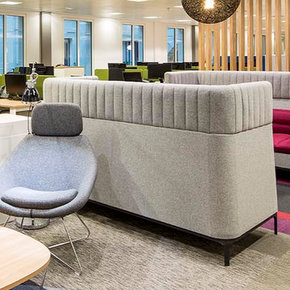
Impact of changing demographics in the workplace
 GUEST BLOG: Michael Page, Joint managing director and workplace consultant at Saracen Interiors considers the shifting average age in the office and looks at what an older team means for those in charge of the facilities.
GUEST BLOG: Michael Page, Joint managing director and workplace consultant at Saracen Interiors considers the shifting average age in the office and looks at what an older team means for those in charge of the facilities.
Third of workers will be 50+ by 2020
The Government has predicted that the changing age profile of the workforce will provide the most significant development in the UK labour market over the coming years. A third of workers will be 50 plus by 2020 and, within another 20 years, almost a quarter of the population will be aged 65 or over.
The ‘younger old’ already walk among us. Au fait with social media and the smart phone, the older generation can hold their own in much more youthful environments than the generation that passed before them – and that includes the office. Workers are now more likely to be encouraged to stay in the labour market while employers, equally, are being primed to value and encourage their older members of staff by making their work feasible and offering a greater degree of flexibility.
Changing the dynamic of the workforce and retaining and employing older faces is driven, in the main, by economics. There are already many who have to work beyond retirement age and this pattern is set to continue – but it’s not just a one-sided requirement.
The rest of society needs older people to work longer. If more young people engage with higher education, there will be a gap and the pension contributions of the workforce will drop without older people to help out. Similarly, the increasing life expectancy age means that there is more pressure on those of working age to support retirees. Having a population that works until it’s older reduces the burden for everyone.
How can we make it easier for older workers?
So how can we make it easier and help to smooth the path of the older workers within the workplace?
Well, first, we need to listen to them. By canvassing the thoughts of older employees when considering a fit out, refurbishment or, indeed, any changes to the office and its facilities, we will have a better idea of what suits them and how best to accommodate their needs. If we ask up front, before any planned changes commence, we have a better chance of getting it right for older members of staff. They will have preferences that may differ from the younger members of the workforce and it’s all about striking that balance.
There are practical considerations that can be taken into account from the outset: Is all signage clear? Is there good access to lifts and is the building easy to negotiate on the whole? Is there a varied mix of work stations with desks at an appropriate height, comfortable seating and optimum lighting (achieved through the use of a good lighting control system)?
An office environment will always be most effective if it is carefully planned to suit everyone. If the environment takes into consideration the needs of disabled employees, for instance, the chances are it will be appropriate for all ages, taking into account all general health and safety requirements and the well being of the team.
Planning office space
When planning office space, it’s good to make it as flexible as possible and work with the office manager to devise a variety of work stations with hubs that support multi-generational teams with all the said practical requirements met. Each generation learns from, and is brought on by, the other so it’s essential to avoid segregating older workers. All ages need to work together so that the older workers can trade their knowledge and experience with the younger workers and bring them on to the next level.
When we create a more blended working place, it’s the older workers that set the tone and provide the example. They’re usually more loyal and reliable in the main and they’re more likely to have an in-depth knowledge of the business.
Our own industry is ready-primed to absorb its fair share of the older workers as it is those individuals who tend to shine when it comes to work like building maintenance. There’s an argument that says we’re moving in a more technical world where older workers, who are new to the industry, may struggle with the shift in emphasis to IT systems and web-based solutions; I think this considers the few rather than the many. The majority who want to work to retirement age and beyond still have the wit and enthusiasm to take on board such changes and we need to work closely with other departments like HR to ensure that a good level of training and support is in place for them.
Maybe it’s because of the longevity of their service and the knowledge they have acquired along the way, but older workers tend to have a can-do attitude and a far more practical and pragmatic approach to the task in hand. They suit our industry well.
It’s often said that age and experience trump education. By engaging a good mix of both within our industry and the wider commercial world, we’re welcoming exciting new times that can dish up a whole new productive vibe. Now’s the time for us to facilitate this.
More about Saracen Interiors on Buildingtalk
Latest news

24th February 2025
Vent-Axia Launches Smart High-Speed Hand Dryer
Vent-Axia has launched the next generation of hand dryer with its Tempest SmartDry high-speed hand dryer. Ticking all the right boxes for a premium hand dryer, the Tempest SmartDry is designed with a built-in HEPA filter, antimicrobial cover, and patented noise-cancelling technology.
Posted in Air Conditioning, Articles, Building Industry News, Building Products & Structures, Building Services, Facility Management & Building Services, Heating, Ventilation and Air Conditioning - HVAC, Innovations & New Products, Restoration & Refurbishment, Retrofit & Renovation
24th February 2025
Hush: Maximising acoustic insulation in floating floors
Hush Acoustics offers acoustic insulation solutions for all types of floating floors to help create quieter, more comfortable homes and acoustically superior non-domestic buildings.
Posted in Acoustics, Noise & Vibration Control, Articles, Building Industry News, Building Products & Structures, Building Services, Facility Management & Building Services, Floors, Insulation, Restoration & Refurbishment, Retrofit & Renovation
24th February 2025
Teledyne FLIR: Thermal imaging for data centres
Data centre maintenance teams have a big share in safeguarding the critical resource that customers and businesses depend upon. Fortunately, they have one secret weapon that enables them to spot issues in an early stage before they turn into big problems – FLIR thermal imaging.
Posted in Articles, Building Industry News, Building Products & Structures, Building Services, Facility Management & Building Services, Information Technology, Innovations & New Products, Posts, Research & Materials Testing, Retrofit & Renovation, Sustainability & Energy Efficiency, Thermal Imaging and Monitors
21st February 2025
ASSA ABLOY EMEIA: Save valuable time and money with a seamless switch to programmable digital keys
In 2025, access management can be a whole lot easier. By making access part of their digital processes, businesses can put time-consuming key management and the cost of changing the locks firmly behind them. Making this switch is a lot easier than many people think, as ASSA ABLOY explains here…
Posted in Access Control & Door Entry Systems, Architectural Ironmongery, Articles, Building Industry News, Building Products & Structures, Building Services, Doors, Facility Management & Building Services, Health & Safety, Information Technology, Innovations & New Products, Retrofit & Renovation, Security and Fire Protection
 Sign up:
Sign up: